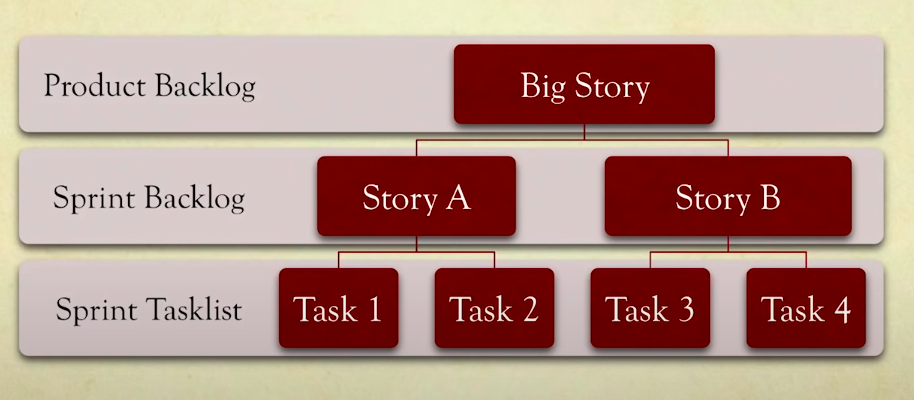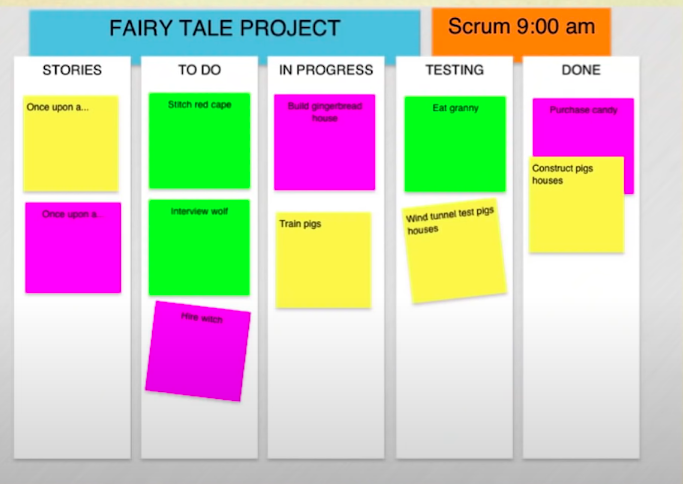Project Management¶
Project Management is the planning, organization, securing, motivation and control of resources to successfully complete a project, while minimizing unproductive efforts
Project Management Models¶
| Advantage | Disadvantages | ||
|---|---|---|---|
| Waterfall | - Concept: Setting the goal - Design: Acquire the requirements, such as programmers - Pre-Production: Verify if the concept and design are feasible - Production - Testing - Alpha - Beta - Shipping - Maintenance | Most of the actual feedback will occur at beta testing, which is too far ahead in the timeline, and hence it will be too late to respond. | |
| Classical Agile | - Individuals and interactions > processes and tools - Working software > comprehensive documentation - Customer collaboration > contract negotiation - Responding rather > over following a plan | Focus on features that consumers want | Assumes interchangeable tasks & team members Depends on good communication |
| Scrum | 1. Transparency - Everyone on the team related to a decision is involved - Shared responsibility 2. Inspection: Anyone on the team curious on why something is the way it is, can 3. Adaptability |
Scrum¶
Keywords¶
| Sprint | Group of tasks to be completed by all teams concurrently |
| Sprint Length | Duration of sprint Usually 1 week |
| Task | Atomic chunk of work an individual can do independently that you can estimate duration for Usually \(\le 8 \text{hrs}\) Usually assigned to 1 person |
Artifacts¶
| Feature | Requirement in User Story format: “As the user/designer/artist, I want something testable so that explain reason" |
| Feature List | List of features |
| Backlog (Product/Project/Sprint) | Prioritized list of functionality which a product should contain, or a project/sprint should achieve Maintained by Product Owner |
| Tasklist | Exhaustive list of tasks |
| Scrumboard | Task list visualized based on status like on Trello |
| Target | Goal “Has to be done in 2days” |
| Estimation | “It’ll take about 2 days to do it” |
| Plan | “I’ll need 2 days to do it” |
| Reality | “It took 2 days to do it” |
Meetings¶
| Meeting | Goal | Details | Timebox |
|---|---|---|---|
| Sprint Planning | Plan sprint backlog by converting project backlog into tasks | 1hr | |
| Daily Scrum/Standups | Accountability & Communication | What did you do since last meeting What will you do until next meeting What is blocking you. Just note this down. Create a new meeting if someone wants to discuss this block | 10min |
| Sprint Review | Review product | Demonstrate working product Review & evaluate product Review & update product backlog | 1hr |
| Retrospective Meeting | Review process | Things to keep doing Things to stop doing New things to try | 30min |
Time-boxing¶
Every thing should be assigned a particular max-duration
If time gets over, go ahead with the best solution possible rather than wasting more time trying to obtain the “perfect” solution
Clear goal & agendas¶
If you don’t know why exactly you are having a meeting, you shouldn’t be having it
Involved participants¶
If someone does not need to be there, don’t force them to attend
People¶
| Person | |
|---|---|
| Product Owner | Has complete understanding of the product Guides the team |
| Scrum Master | Administrative Runs the meetings Facilitator Mediator |
| Team Member |
Ideally Product Owner and Scrum master should always be different, as each of their roles is very tiring as is.
Feature Size¶
Categorize features as S, M, L
IDK
- Discuss as an entire team whenever possible
- Each role should try to lend its perspective
- Listen & try to make sense of what others are saying
- Offer alternate solutions & point out problems
- Divide huge features into atomic features
- Everyone related to the decision should be there
- Everyone should agree on the feature size
- Don’t average out the opinions if someone says S & another person says L, don’t conclude it’s M
- Should not take too long. If you get stuck on a feature, put it aside & come back to it
Estimation¶
Get a clear view of project reality to make informed decisions to control project to hit targets. You need to identify what the team is capable of, not what you can/want to happen
---
title: Estimation
---
flowchart LR
subgraph pb[Product Backlog]
direction LR
f1[Feature 1]
f2[Feature 2]
end
subgraph sb[Sprint Backlog]
direction LR
t1[Task 1]
t2[Task 2]
end
pb --> Size --> Effort --> People --> Time --> sb- Don’t estimate in “ideal work hours”
- Include breaks, distractions & meetings in the estimate
Need to know the __ of your estimates
- Uncertainty
- Accuracy
- Precision
You need to commit to a point estimate; don’t use the average of a range.
Estimation \(\ne\) Planning¶
| Planning | Estimation | |
|---|---|---|
| Goal | Achieve a target | Verify if plan is realistic |
| Commitment occurs when | Person accepts a task | when estimation is accurate (not necessary person takes up the task) |
| Nature | Fixed | Variable Re-estimate as you work on the task |
Tracking Estimates¶
| Feature | Task | Original Estimate | Elapsed | Remaining | Current Estimate |
|---|---|---|---|---|---|
Get summary statistics of feature’s resources
Use this for better estimating in the future
Compare against feature size
Backlog to Tasklist¶

By breaking up story into tasks, you can understand all dependencies & potential overloading of individuals
Scrum Board¶
| Doing |
| Todo-This Sprint |
| Todo-Long Term |
| Discussion |
| Testing |
| Completed |
| Cancelled |

References¶
- https://www.youtube.com/playlist?list=PLUl4u3cNGP61V4W6yRm1Am5zI94m33dXk
- IIT Roorkee July 2018 | Project Management